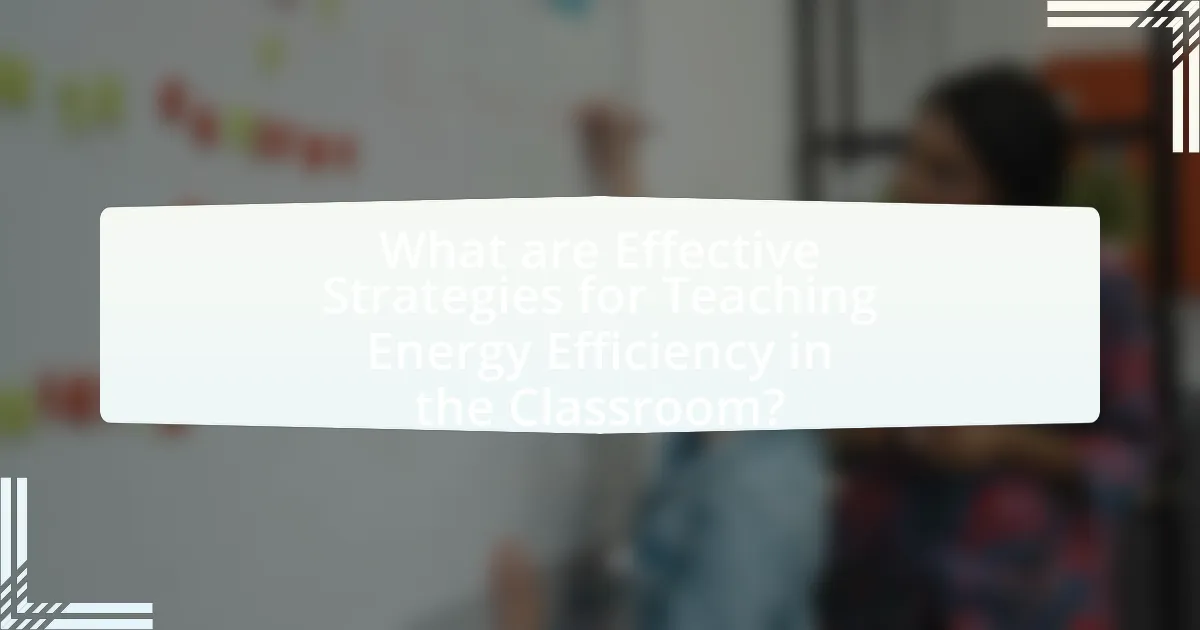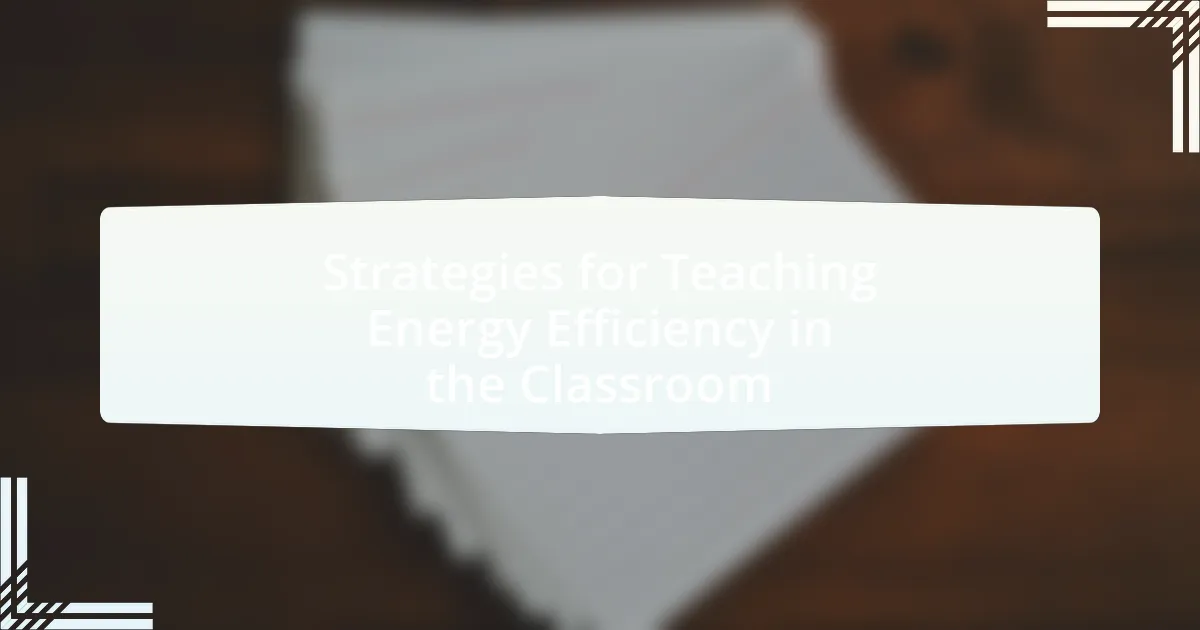The article focuses on effective strategies for teaching energy efficiency in the classroom, emphasizing hands-on activities, real-world applications, and technology integration. It outlines methods for introducing energy efficiency concepts, the foundational knowledge students should possess, and the importance of real-world examples in enhancing understanding. Additionally, the article discusses the role of interactive learning, the impact of energy efficiency education on student behavior, and the significance of assessing student comprehension through various evaluation methods. It also highlights available resources and best practices for implementing energy efficiency strategies in educational settings.

What are Effective Strategies for Teaching Energy Efficiency in the Classroom?
Effective strategies for teaching energy efficiency in the classroom include hands-on activities, real-world applications, and integrating technology. Hands-on activities, such as energy audits of the classroom or school, allow students to identify energy waste and propose solutions, fostering critical thinking and problem-solving skills. Real-world applications, like projects that involve calculating energy consumption or creating energy-saving plans, help students understand the practical implications of energy efficiency. Integrating technology, such as using energy monitoring tools or simulations, enhances engagement and provides immediate feedback on energy usage. Research indicates that experiential learning significantly improves retention and understanding of energy concepts, making these strategies effective in promoting energy efficiency education.
How can educators introduce the concept of energy efficiency to students?
Educators can introduce the concept of energy efficiency to students by incorporating hands-on activities that demonstrate energy consumption and conservation. For instance, conducting experiments where students measure the energy usage of various appliances can provide tangible insights into energy efficiency. Research indicates that experiential learning significantly enhances understanding; a study by the National Energy Education Development Project found that students who engaged in practical energy-saving projects improved their knowledge retention by 30%. By utilizing real-world examples and interactive lessons, educators can effectively convey the importance of energy efficiency in daily life.
What foundational knowledge should students have before learning about energy efficiency?
Students should have a basic understanding of energy concepts, including types of energy (kinetic, potential, thermal), energy transfer, and the laws of thermodynamics before learning about energy efficiency. This foundational knowledge is crucial as it allows students to comprehend how energy is consumed and conserved in various systems. For instance, understanding the first law of thermodynamics, which states that energy cannot be created or destroyed, helps students grasp the importance of efficiency in energy use. Additionally, familiarity with renewable and non-renewable energy sources provides context for discussions on sustainable practices and energy-saving technologies.
How can real-world examples enhance understanding of energy efficiency?
Real-world examples enhance understanding of energy efficiency by providing tangible contexts that illustrate abstract concepts. For instance, case studies of energy-efficient buildings, such as the Bullitt Center in Seattle, demonstrate practical applications of energy-saving technologies like solar panels and rainwater harvesting systems. These examples allow learners to visualize the impact of energy efficiency measures, making the information more relatable and easier to grasp. Additionally, statistics from the U.S. Department of Energy indicate that buildings designed with energy efficiency in mind can reduce energy consumption by up to 50%, reinforcing the importance of these concepts through concrete data.
What teaching methods are most effective for energy efficiency education?
Interactive and experiential learning methods are most effective for energy efficiency education. These approaches engage students actively, allowing them to apply concepts in real-world scenarios. For instance, hands-on activities such as energy audits and simulations have been shown to enhance understanding and retention of energy efficiency principles. Research conducted by the National Energy Education Development Project indicates that students participating in interactive learning experiences demonstrate a 30% increase in knowledge retention compared to traditional lecture-based methods. This evidence supports the effectiveness of interactive and experiential learning in teaching energy efficiency.
How can hands-on activities promote learning about energy efficiency?
Hands-on activities promote learning about energy efficiency by engaging students in practical applications that illustrate energy concepts. These activities allow learners to experiment with energy-saving techniques, such as building models of energy-efficient homes or conducting experiments to measure energy consumption. Research indicates that experiential learning enhances retention and understanding; for instance, a study by the National Energy Education Development Project found that students who participated in hands-on energy efficiency projects demonstrated a 30% increase in knowledge retention compared to traditional learning methods. This active involvement not only reinforces theoretical knowledge but also fosters critical thinking and problem-solving skills related to energy use and conservation.
What role does technology play in teaching energy efficiency?
Technology plays a crucial role in teaching energy efficiency by providing interactive tools and resources that enhance learning experiences. For instance, simulations and modeling software allow students to visualize energy consumption and efficiency in real-time, making abstract concepts more tangible. Research indicates that using technology, such as energy monitoring devices and educational apps, can increase student engagement and understanding of energy-saving practices. A study published in the Journal of Environmental Education Research found that students exposed to technology-based energy efficiency lessons demonstrated a 30% increase in knowledge retention compared to traditional teaching methods. This evidence underscores the effectiveness of technology in fostering a deeper comprehension of energy efficiency principles.
Why is it important to teach energy efficiency in schools?
Teaching energy efficiency in schools is crucial because it fosters sustainable habits in students that can lead to long-term environmental benefits. By integrating energy efficiency education into the curriculum, schools can equip students with the knowledge to reduce energy consumption, which is essential for combating climate change. Research indicates that educating young people about energy-saving practices can significantly lower energy use in households; for instance, a study by the American Council for an Energy-Efficient Economy found that energy efficiency education can lead to a 10-20% reduction in energy consumption among students’ families. This not only contributes to environmental sustainability but also promotes economic savings for families and communities.
What impact does energy efficiency education have on student behavior?
Energy efficiency education significantly influences student behavior by promoting sustainable practices and increasing awareness of energy consumption. Research indicates that students exposed to energy efficiency curricula demonstrate improved energy-saving behaviors, such as turning off lights and unplugging devices when not in use. A study conducted by the National Energy Education Development Project found that students who participated in energy efficiency programs reduced their energy usage by an average of 15%. This behavioral change is attributed to enhanced understanding of energy conservation principles and the environmental impact of energy waste.
How does teaching energy efficiency contribute to environmental awareness?
Teaching energy efficiency significantly enhances environmental awareness by equipping individuals with knowledge about resource conservation and its impact on the planet. When students learn about energy-efficient practices, they understand how reducing energy consumption can lead to lower greenhouse gas emissions, which are a major contributor to climate change. For instance, studies show that educating students about energy-saving technologies can lead to a 10-20% reduction in energy use in schools, demonstrating a direct link between knowledge and behavior change. This understanding fosters a sense of responsibility towards the environment, encouraging individuals to adopt sustainable practices in their daily lives.
How can teachers assess student understanding of energy efficiency?
Teachers can assess student understanding of energy efficiency through a combination of formative assessments, project-based learning, and quizzes. Formative assessments, such as class discussions and interactive activities, allow teachers to gauge students’ grasp of concepts in real-time. Project-based learning, where students create energy audits or design energy-efficient solutions, provides practical application and deeper understanding. Quizzes can evaluate retention of key terms and principles related to energy efficiency. Research indicates that active engagement in learning activities significantly enhances comprehension, as shown in studies like those by Hattie (2009), which emphasize the effectiveness of formative assessments in improving student outcomes.
What types of assessments are most effective for evaluating knowledge of energy efficiency?
Formative assessments, such as quizzes, practical demonstrations, and project-based evaluations, are most effective for evaluating knowledge of energy efficiency. These assessments allow educators to gauge students’ understanding in real-time and provide immediate feedback. For instance, a study published in the Journal of Environmental Education Research found that hands-on projects, where students design energy-efficient solutions, significantly enhance comprehension and retention of energy efficiency concepts. Additionally, formative assessments encourage active learning and critical thinking, which are essential for grasping complex topics like energy efficiency.
How can feedback be used to improve energy efficiency education?
Feedback can be used to improve energy efficiency education by providing learners with specific insights into their understanding and application of energy-saving concepts. This targeted feedback allows educators to identify misconceptions and adjust instructional strategies accordingly, enhancing the overall learning experience. For instance, studies show that formative assessments, which include feedback, can lead to a 20% increase in student performance in energy-related subjects. By incorporating regular feedback mechanisms, such as quizzes and peer reviews, educators can foster a more interactive learning environment that encourages continuous improvement in energy efficiency knowledge and practices.
What resources are available for teaching energy efficiency in the classroom?
Resources available for teaching energy efficiency in the classroom include educational materials, interactive tools, and curriculum guides. Organizations such as the U.S. Department of Energy provide resources like the Energy Efficiency and Renewable Energy (EERE) website, which offers lesson plans and activities tailored for various grade levels. Additionally, the National Energy Education Development (NEED) Project supplies comprehensive curriculum guides and hands-on activities that engage students in learning about energy efficiency. These resources are validated by their widespread use in educational settings and their alignment with national science standards, ensuring that they effectively support teaching objectives.
What online tools and platforms can support energy efficiency education?
Online tools and platforms that support energy efficiency education include Energy Star’s online resources, the U.S. Department of Energy’s Energy Efficiency and Renewable Energy (EERE) website, and the Green Building Advisor. Energy Star provides educational materials and interactive tools that help users understand energy efficiency in appliances and homes. The EERE website offers comprehensive guides, data, and case studies on energy-efficient technologies and practices. The Green Building Advisor serves as a resource for sustainable building practices, including energy efficiency strategies. These platforms collectively enhance understanding and implementation of energy efficiency concepts in educational settings.
How can teachers collaborate with local organizations to enhance energy efficiency lessons?
Teachers can collaborate with local organizations by establishing partnerships that provide resources, expertise, and real-world applications for energy efficiency lessons. For instance, local energy companies can offer workshops, guest speakers, or field trips to facilities that demonstrate energy-saving technologies. Research indicates that hands-on experiences significantly enhance student engagement and understanding of energy concepts. Additionally, organizations may provide educational materials or funding for projects that allow students to conduct energy audits in their schools or homes, reinforcing practical applications of their learning. Such collaborations not only enrich the curriculum but also foster community involvement in energy conservation efforts.
What are some best practices for implementing energy efficiency strategies in the classroom?
Best practices for implementing energy efficiency strategies in the classroom include conducting an energy audit, utilizing energy-efficient lighting, and incorporating technology for monitoring energy use. Conducting an energy audit helps identify areas where energy is wasted, allowing for targeted improvements. Utilizing LED lighting can reduce energy consumption by up to 75% compared to traditional incandescent bulbs. Incorporating smart technology, such as programmable thermostats and energy monitoring systems, enables real-time tracking of energy usage, fostering awareness and encouraging energy-saving behaviors among students. These practices collectively contribute to a more sustainable classroom environment.

Leave a Reply